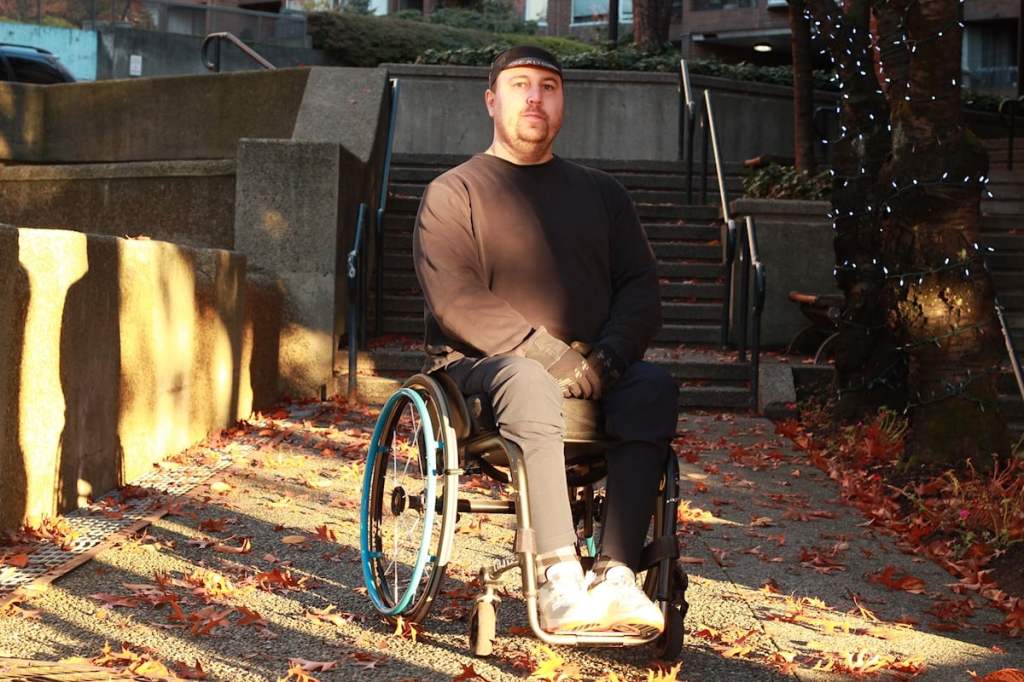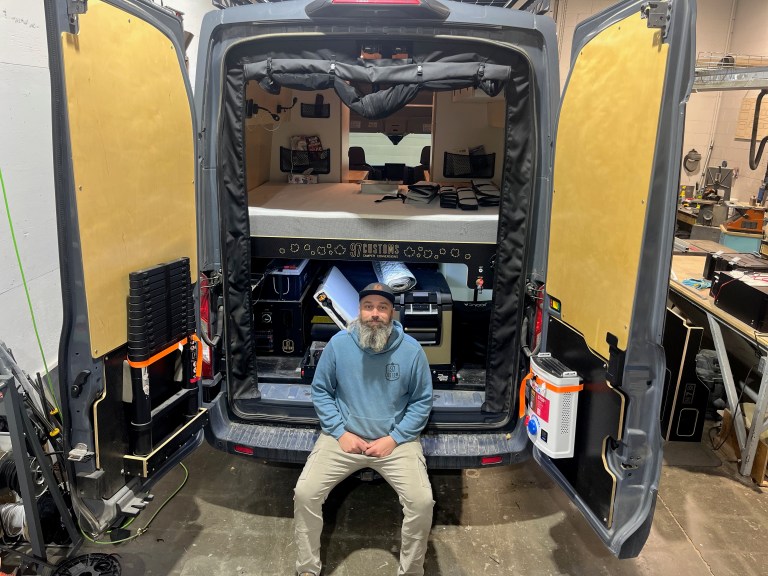

British Columbians who use manual and power wheelchairs say they’re tearing their hair out trying to get local businesses to service and maintain their wheelchairs.
Delays can lead to weeks or even months of people being stuck at home or in bed while they wait for repairs, completely disrupting their work and social schedules. Being stuck in bed for an extended period can even lead to hospitalizations if pressure wounds or bedsores develop.
Wheelchair repair companies are aware of these problems but are struggling to meet the demand because of business constraints imposed by the provincial government, said one local business owner.
The Tyee asked to speak with Minister of Social Development and Poverty Reduction Sheila Malcolmson about these delays and about what could be done about them, but she was not made available.
Instead the ministry sent an email outlining when equipment is eligible for repairs or replacement.
The ministry said it is working on supporting vulnerable British Columbians as part of its poverty reduction strategy but did not acknowledge how repair delays are affecting vulnerable people.
Jocelyn Maffin, associate director of Spinal Cord Injury BC, said that when it comes to the mobility device industry, “the level of dissatisfaction is pretty high at any given time.”
It’s common for customers to cycle through loving a new store, hating it two years later and finding a new vendor to repeat the cycle with, she said.
In the first part of this two-part series, The Tyee will look at how businesses are struggling to meet industry demand and how that is affecting customers. In the second part, The Tyee will examine solutions.
How delays affect customers
Vancouverite and former bike mechanic Olivia Locke told The Tyee she’s spent the last year and a bit going back and forth with National Seating & Mobility, the company that sold her a manual wheelchair and parts for her SmartDrive power assist device, which she bought second-hand.
The SmartDrive works a bit like an e-assist on an e-bike. It clips onto the back of a manual wheelchair and offers boosts to help people get themselves up hills or maintain a steady speed.
Locke said the government paid for the wheelchair and she paid for the SmartDrive out of pocket.
The equipment combo meant Locke could better navigate the steep hills in her Vancouver neighbourhood and that her chair was light enough to load into the back of her car.
Then the SmartDrive ran her into walls at top speed, twice.
The dial that was used to engage the SmartDrive has since been recalled, but Locke said it was the customer service, rather than the faulty device, that really frustrated her.
It’s been extremely challenging to work with National Seating & Mobility, she said. For example, when her SmartDrive stopped working, the company wouldn’t lend her a replacement SmartDrive while it completed repairs. This meant she was often stranded in her home.
The Tyee asked for an interview with National Seating & Mobility but did not hear back. The company also did not respond to emails and followups in which The Tyee listed the complaints customers had with its service and asked for its response.
Locke showed The Tyee emails she’s sent to the company over the past year. Many went unanswered or the company’s reply didn’t address her specific questions about refunds, if it had ordered a part she’d requested or if she could cancel her repair and get her gear back so she could take her business elsewhere.

But ordering parts online can be difficult, Gillis said, because so many wheelchair parts are so proprietary or customizable that it’s tricky even for an experienced mechanic to be sure they’re ordering the correct item.
Something as straightforward as a seat cushion can cost $700, Gillis said, and then the Velcro straps on the chair and cushion might not line up.
“If you fuck up the purchase there’s no returns,” they added.
Gillis, like Locke, has also found businesses difficult to correspond with. They were forced, for example, to abandon a $600 set of wheels that they bought but were never sent, despite months of hounding the store.
“I ended up being so frustrated that I just gave up,” they told The Tyee.
While Gillis has considered stockpiling parts, they said the strategy can be cost prohibitive and the parts can take up a lot of room in a one-bedroom apartment.
Hilary Mason’s 20-year-old son Josh is autistic and has used a wheelchair since he was three. Mason told The Tyee she spends between one and eight hours a week advocating for wheelchair repairs and can sometimes wait up to three weeks to get a response.
Mason said her family is lucky to have private insurance, which enabled them to get a second identical wheelchair and swap parts out to “cobble together one functioning chair.”
But even then it can take months for parts to come in, or the chair can break down. This causes a crisis because Josh is then trapped in his bed without warning or explanation, she said.
She said part of her frustration is how hard a company can be to get in touch with, adding she’s toyed with the idea of ordering pizza to the site with messages written on the box in hopes of getting a response.
Local business owner says his hands are tied
Greg Hamada said he’s aware of these complaints and feels for his customers but his hands are somewhat tied. Hamada is a pseudonym. The Tyee sent interview requests to several wheelchair vendors in the Lower Mainland and heard back from only one owner, who said he’d agree to an interview only if he could be anonymous.
Hamada’s company has been selling and repairing wheelchairs and other mobility devices in Vancouver for over two decades.
He said businesses want to help their customers but are hugely constrained by the government’s master standing agreement.
The umbrella agreement lays out how the government pays for medical equipment through the Ministry of Social Development and Poverty Reduction, Ministry of Child and Family Development, ICBC and WorkSafeBC.
Most established businesses in B.C. have signed on to this agreement, which Hamada said pays for around 70 per cent of his business. The other 30 per cent is from customers paying out of pocket or through private insurance.
Maffin of Spinal Cord Injury BC told The Tyee people covered by private insurance make up a “tiny” number compared with those covered by the government.
Under the master standing agreement, when a customer asks for repairs a technician has to assess the problem, generate a quote for repairs, send it to the government and wait for approval before doing any repairs.
This can include unpaid travel time for technicians making house calls to wheelchair users’ homes.
It also includes a lot of delays. Locke said she requested repairs from National Seating & Mobility two months ago and was just recently told that the company submitted a quote to the ministry.
The Ministry of Social Development and Poverty Reduction said its approval process typically takes 10 to 15 business days.
Hamada said approvals can take two weeks to one month.
This makes it “basically impossible” to get urgent and straightforward repairs, such as flat tire fixes, done quickly, Gillis said.
“If you get a flat and need it repaired you’re completely out of luck,” they said.
Mason told The Tyee the process also often feels unnecessary. “I can look at a wheelchair and tell you what part it needs after more than 20 years dealing with wheelchairs,” she said.
More staff needed, but no more staff hired
Compounding the problem: technicians are incredibly busy but companies aren’t always able to hire more staff to ease their workload, Hamada said, despite high industry demand.
This is due to the expenses companies have to take on that are not covered by the government or an item’s sale price, Hamada added.
He said businesses across B.C. are expected to provide two years of free service on everything they sell, cover the cost of batteries in mobility scooters or electric wheelchairs, not charge for travel time, and freeze the price of mobility scooters and power lifts so they don’t increase past what they cost in 2010.
“It’s really hard to service something for two years when you’re not getting paid for it,” he said. “We can’t pay for more service technicians. And the technicians we have spend the majority of their time doing zero-dollar work orders, taking the place of other clients who might have cash in hand.”
He said not getting paid for batteries means the company loses around $1,200 every time it sells a scooter or electric wheelchair.
The Ministry of Social Development and Poverty Reduction confirmed that batteries are initially supplied at no extra cost under the master standing agreement, but added the ministry covers the cost of replacement batteries.
Funding caps on scooters and patient lifts, Hamada said, push companies to try to source cheaper products, which tend to break down more, requiring more free repairs.
“We’re not saving any money by capping this equipment,” he said. “We’re actually spending more on repairs and people are being pushed into the wrong pieces of equipment.”
Some retailers are hesitant or refuse to sell scooters because of the funding cap, Hamada said, which means more customers end up in electric wheelchairs, which cost around $10,000 more than a scooter.
The price of a wheelchair varies widely depending on the needs of the user. Sources told The Tyee their manual wheelchairs cost between $6,500 and $8,000, and their power wheelchairs cost between $16,000 and $50,000. More expensive chairs can have added features, such as a seat that lifts up, which can help people reach all of the buttons in an elevator.
Hamada said his company hasn’t made money since before the pandemic.
When The Tyee went back to Locke after speaking with Hamada, she said it sounded like businesses are in a tough spot. But she said she doesn’t accept those difficulties with the government as an excuse for the way she has been treated as a customer.
If government expectations are making it impossible to run a business, then businesses need to work that out with the province without letting it affect their customers, she said.
Disabled people “can’t be expected to change the whole system so they can get a flat tire fixed,” Locke said.
If National Seating & Mobility couldn’t take her on as a customer, then she should have been told that before she bought a wheelchair through the company, she said. If the company couldn’t honour the warranty on the SmartDrive, then it should never have sold her parts for it, she added.
People in government-funded wheelchairs will get a new chair every five years, which is important because the chair is pretty beaten up by then and a person’s body has usually changed during that time, said Spinal Cord Injury BC’s Maffin.
But Gillis and Mason said the five-year timeline isn’t set in stone. Gillis said they “fell through the cracks” when they didn’t have a doctor advocating for them to get a new chair, and Mason said she’s been waiting almost a year for her son to be seen by an occupational therapist to start the replacement process.
— This story was originally published by The Tyee
Join the Conversation!
Want to share your thoughts, add context, or connect with others in your community?
You must be logged in to post a comment.














